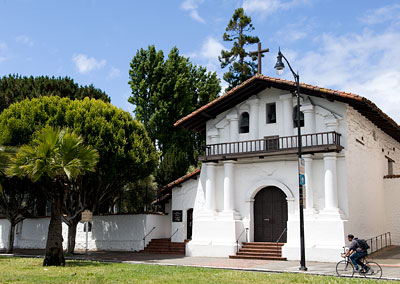National Register of Historic Places in San Francisco
Mission Dolores
AKA Misión San Francisco de Asís
Dolores Street at 16th Street
Built 1782-1791
Mission Dolores, the oldest essentially unaltered building in San Francisco, was built by the Franciscan Fathers and the Mission Indians. It has been continuously used as a church.
The present Mission stands on or near the site of the original Mission founded in 1776 by Father Francisco Palou under the direction of Father Junipero Serra. The first Mass was celebrated on 29 June 1776 five days prior to the signing of the Declaration of Independence.
The Mission's popular name arose from its location near the lagoon named Laguna de Nuestra Señora de los Dolores by the Spaniards (California Landmark 327-1).
Mission Dolores is an excellent example of the Spanish Mission style of architecture prevalent in Mexico and California during the late 18th century. The walls of sun-dried adobe brick are four feet thick. The roof beams are of redwood, and the sloping roof is of tiles made by the Mission Indians. The floors are a mixture of clay, burned tile, brick and wood. There are no nails in the building, which is secured by means of wooden pegs and rawhide.
A structural renovation was carried out in 1920 under the direction of Willis Polk including restoration of some details and strengthening of the building.
Adjacent to the Mission and its cemetery are religious structures and administrative offices of the Archdiocese, including the large Spanish Baroque church which adjoins the Mission on the north and which bears the title of Basilica, one of a very few such ever created in the United States.
The surrounding area is primarily developed and zoned for multiple-family residences.
Excerpted from the NRHP Nomination.

Mission Dolores was one of the models for the Mission Revival architectural style which was popular in California at the end of the 19th century and beginning of the 20th century.

Mission Dolores is also San Francisco Landmark 1.
